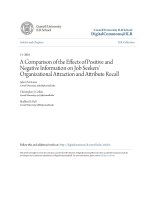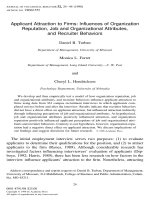Tài liệu tiếng anh tham khảo impact of job stress on employee’s performace of sales department
Bạn đang xem bản rút gọn của tài liệu. Xem và tải ngay bản đầy đủ của tài liệu tại đây (489.24 KB, 11 trang )
62
This article can be downloaded from />Int. J. Mgmt Res. & Bus. Strat. 2013 Anil Chandhok and Mansi Monga, 2013
IMPACT OF JOB STRESS ON EMPLOYEE'S
PERFORMANCE OF SALES DEPARTMENT:
A COMPARATIVE STUDY OF LIC AND BAJAJ
ALLIANZ LIFE INSURANCE COMPANY LTD
IN THE SELECTED CITIES OF HARYANA
Anil Chandhok
1*
and Mansi Monga
1
Over the years, a lot of research has been carried out in the realm of work place stress and it
has been emphatically proven that intense or prolonged stress leads to a negative impact on
one’s mental and physical well being. Even though a fair degree of stress may be felt in all
occupations, some work places have been known to experience more stress compared to
others. Life insurance sector is one of the sectors were the employee’s monetary benefits are
based on their sales targets although reasonable salary is given to them which is fixed and not
based on target achievements. It is a normal tendency, people avoid life insurance and prefers
to invest their money where high returns are expected. Keeping this philosophy in mind, it is a
challenge for the sales team to convince the prospects and sell them insurance products. This
research paper is an attempt to find out the degree of stress between the employee’s of LIC and
the employee’s of Bajaj Allianz Life Insurance Company.
Keywords: Insurance companies, Job stress, Emphatic, Emotional
*Corresponding Author: Anil Chandhok,
INTRODUCTION
Relationship between Stress and Work
Performance
Various studies have been conducted to examine
the relationship between job stress and job
performance. Job performance can be viewed
as an activity in which an individual is able to
accomplish the task assigned to him/her
successfully, subject to the normal constraints
of reasonable utilization of the available resources.
1
Professor, Maharishi Markandeshwar University, M M University, Mullana (Ambala).
Int. J. Mgmt Res. & Bus. Strat. 2013
ISSN 2319-345X www.ijmrbs.com
Vol. 2, No. 1, January 2013
© 2013 IJMRBS. All Rights Reserved
At a conceptual level, three types of relationships
were proposed to exist between the measures
of job stress and job performance (Jamal, 2007).
One is a negative linear relationship, when
productivity decreases with stress (distress).
Productivity can also increase as a consequence
of stress, thereby implying a positive linear
relationship between the two. Thirdly, there could
be a U-shaped or a curvilinear relationship
wherein, mild stress could increase the
63
This article can be downloaded from />Int. J. Mgmt Res. & Bus. Strat. 2013 Anil Chandhok and Mansi Monga, 2013
productivity initially up to a peak and then it
declines as the person descends into a state of
distress. Alternately, there need not be any
quantifiable relationship between the two.
INDUSTRY PROFILE
Life Insurance in its modern form came to India
from England in the year 1818. Oriental Life
Insurance Company started by Europeans in
Calcutta was the first life insurance company on
Indian Soil. All the insurance companies
established during that period were brought up
with the purpose of looking after the needs of
European community and Indian natives were not
being insured by these companies. Bharat
Insurance Company (1896) was also one of such
companies inspired by nationalism.
The Insurance Act 1938 was the first legislation
governing not only life insurance but also non-life
insurance to provide strict state control over
insurance business. The demand for nationaliza-
tion of life insurance industry was made
repeatedly in the past but it gathered momentum
in 1944 when a bill to amend the Life Insurance
Act 1938 was introduced in the Legislative
Assembly. Nationalization was accomplished in
two stages; initially the management of the
companies was taken over by means of an
Ordinance, and later, the ownership too by means
of a comprehensive bill. The Parliament of India
passed the Life Insurance Corporation Act on the
19th of June 1956, and the Life Insurance
Corporation of India was created on 1st
September, 1956, with the objective of spreading
life insurance much more widely and in particular
to the rural areas with a view to reach all insurable
persons in the country, providing them adequate
financial cover at a reasonable cost. Since life
insurance contracts are long term contracts and
during the currency of the policy , it requires a
variety of services, need was felt in the later years
to expand the operations and place a branch office
at each district headquarter. Re-organization of
LIC took place and large numbers of new branch
offices were opened. From then to now, LIC has
crossed many milestones and has set
unprecedented performance records in various
aspects of life insurance business. The same
motives which inspired our forefathers to bring
insurance into existence in this country inspire
us at LIC to take this message of protection to
light the lamps of security in as many homes as
possible and to help the people in providing
security to their families.
RESEARCH OBJECTIVES
1. To explore comparative difference in the job
stress of employees of Life Insurance
Corporation of India and Bajaj Allianz life
insurance company ltd.
2. To analyze the impact of job stress on perfor-
mance of employees.
3. To suggest some policy recommendations
that can be adopted to improve the perfor-
mance of the employees.
4. To study the recent practices adopted by
these organizations to reduce stress.
Hypothesis
H
01
: There is no significant difference in the
stress level of the Life Insurance
Corporation of India and Bajaj Allianz
insurance Company ltd.
H
02
: There is no linear co-relation between job
stress and work performance of employees.
64
This article can be downloaded from />Int. J. Mgmt Res. & Bus. Strat. 2013 Anil Chandhok and Mansi Monga, 2013
Scope of the Study
To under take the study, convenience sampling
method was used so that the respondent can give
a clear and fair picture about his/her feeling
towards the stress at work place. The study is
limited to the three levels of employees designa-
ted as Branch Manager/Assistant Branch
Manager Sales Manager and Development
Officers of Life Insurance Corporation of India and
Bajaj Allianz Insurance Limited.
SAMPLE SIZE
A sample of 160 employees have been contacted
(80 each from LIC and BALIC). These employees
are working for New Business Development. The
samples were taken from the selected branches
falling in the state of Haryana.
Table 1: Are you Satisfied With the Benefits Being Provided by the Company?
S. No. Contents Life Insurance Corporation of India Bajaj Allianz Insurance Company Ltd.
1 Strongly Satisfied 35 41
2 Satisfied 38 30
3 Moderate 7 9
4 Dissatisfied - -
5 Strongly Dissatisfied - -
Total 80 80
Source: Self prepared questionnaire and field survey
Table 2: What More Benefits do you Expect from the Company for Removing Your Job Stress?
S. No. Contents Life Insurance Corporation of India Bajaj Allianz Insurance Company Ltd.
1 Bonus 21 19
2 More Salary 23 16
3 Promotion 18 26
4 Reward 13 14
5 Medical Facility 5 5
Total 80 80
Source: Self prepared questionnaire and field survey
Table 3: Are You Satisfied With The Working Environment Provided By The Company?
S. No. Contents Life Insurance Corporation of India Bajaj Allianz Insurance Company Ltd.
1 Yes 30 65
2 No 50 15
Total 80 80
65
This article can be downloaded from />Int. J. Mgmt Res. & Bus. Strat. 2013 Anil Chandhok and Mansi Monga, 2013
Table 4: Are You Satisfied With The Incentive Plans Made By The Company?
S. No. Contents Life Insurance Corporation of India Bajaj Allianz Insurance Company Ltd.
1 Strongly Agree 58 15
2 Agree 22 19
3 Moderate - 21
4 Disagree - 16
5 Strongly disagree - 19
Total 80 80
Source: Self prepared questionnaire and field survey
Table 5: Analyze the Factors Which Are Responsible for Work Overload
S. No. Contents Life Insurance Corporation of India Bajaj Allianz Insurance Company Ltd.
1 Co-workers are inefficient 32 13
2 Cannot consult with worker 2 34
3 Complete work at home 5 10
4 Shortage of help 41 23
Total 80 80
Source: Self prepared questionnaire and field survey
Table 6: Which of the Following Gives Maximum Stress?
S. No. Contents Life Insurance Corporation of India Bajaj Allianz Insurance Company Ltd.
1 Work overload 34 39
2 Work under load - 16
3 Time pressure 15 20
4 Health 31 5
5 Total 80 80
Source: Self prepared questionnaire and field survey
Table 7: Analyze the Stress Level of Employees on the Basis of These Factors
S. No. Contents Life Insurance Corporation of India Bajaj Allianz Insurance Company Ltd.
1 Work load 15 35
2 Time pressure 10 12
3 Promotion 19 25
4 Salary 11 8
5 Pension 25 0
Total 80 80
Source: Self prepared questionnaire and field survey
66
This article can be downloaded from />Int. J. Mgmt Res. & Bus. Strat. 2013 Anil Chandhok and Mansi Monga, 2013
DATA ANALYSIS
Hypothesis 1
H
0
: There is no significant difference in the stress
level of the life insurance corporation of India
and Bajaj Allianz insurance Company ltd.
H
1
: There is a significant difference in the stress
level of the life insurance corporation of India
and Bajaj Allianz insurance Company ltd.
Chi-square =
2
O E
E
= 152/80 = 1.9
where O=observed frequency and E=expected
frequency
Degree of freedom = n – 1
= 5 – 1 = 4 = 9.49
In this case chi-square value is less than
tabulated value so we can say that null hypothesis
is accepted in this case.
Chi-square =
2
O E
E
= 778/ 80 = 9.49
where O=observed frequency and E=expected
frequency
Degree of freedom = n – 1
= 5 – 1 = 4
= 9.725
In this case chi-square value is more than
tabulated value so we can say that null hypothesis
is rejected in this case.
Hypothesis 2
Table 8: Table of Life Insurance Corporation of India
Contents Observed frequency Expected frequency O – E (O – E)
2
(O-E)
2
/E
Work load 15 16 -1 1 0.062
Time pressure 10 16 -6 36 2.25
Promotion 19 16 3 9 0.56
Salary 11 16 -5 25 1.56
Pension 25 16 9 81 5.06
Total 152 9.49
Table 9: Bajaj Allianz Insurance Company Limited
Contents Observed frequency Expected frequency O – E (O – E)
2
(O-E)
2
/E
Work load 35 16 19 361 22.56
Time pressure 12 16 -4 16 1
Promotion 25 16 9 81 5.06
Salary 8 16 -8 64 4
Pension 0 16 -16 256 16
Total 778 48.62
67
This article can be downloaded from />Int. J. Mgmt Res. & Bus. Strat. 2013 Anil Chandhok and Mansi Monga, 2013
Chi-square =
2
O E
E
= 514/80 = 6.425
where O=observed frequency and E=expected
frequency
Degree of freedom = n – 1
= 5 – 1 = 4
= 9.49
In this case chi-square value is less than
tabulated value so we can say that null hypothesis
is accepted in this case.
H
0
: there is no linear co-relation between job
stress and work performance of employees.
H
1
: there is a linear co-relation between job
stress and work performance of employees.
Chi-square =
2
O E
E
= 1016/ 80
= 63.5
where O=observed frequency and E=expected
frequency
Degree of freedom = n – 1
= 5 – 1 = 4
= 9.725
In this case chi-square value is more than
tabulated value so we can say that null hypothesis
is rejected in this case.
FINDINGS
After going through the research on Life insurance
Table 10: Life Insurance Corporation of India
Contents Observed frequency Expected frequency O – E (O – E)
2
(O-E)
2
/E
Excellent 35 16 19 361 22.5
Above average 18 16 2 4 0.25
Average 15 16 1 1 0.06
Below average 18 16 2 4 0.25
Unsatisfactory 4 16 12 144 9
Total 514 23.06
Table 11: Bajaj Allianz Insurance Company Limited
Contents Observed frequency Expected frequency O – E (O – E)
2
(O-E)
2
/E
Excellent 14 16 2 4 0.25
Above average 22 16 6 36 2.25
Average 40 16 24 576 36
Below average 4 16 12 144 9
Unsatisfactory 0 16 16 256 16
Total 1016 63.5
68
This article can be downloaded from />Int. J. Mgmt Res. & Bus. Strat. 2013 Anil Chandhok and Mansi Monga, 2013
Corporation of India and Bajaj Allianz insurance
Company Ltd., it is observed that both the
companies are having different atmosphere from
each other and there are different factors of job
stress causing stress on the employee’s
performance . In Life Insurance Corporation of
India, job stress is less as compare to Bajaj Allianz
Insurance company Ltd. Bajaj Allianz insurance
company Ltd has more job stress regarding time
pressure, more supervision, fired without cause
any time, insecurity about the job, work overload
and on the side in case of Life Insurance
Corporation of India, Work load is a cause of
concen for job stress. The object of preparing
this report is to explore comparative difference in
the job stress of employees of life insurance
Corporation of India and Bajaj Allianz life insurance
company ltd. The important findings of the study
are as under:
• Benefits which are provided by Bajaj Allianz
insurance company ltd , their employees are
more satisfied as compare to the LIC
employee’s. LIC employees are more
demanding.
• Employee’s of both the companies desires
more benefits like bonus, promotion which
helps to brighten their careers.
• As compare to B.A.I.C.L, LIC has low job
stress regarding competition in the market
because LIC has 71% total share of the market
and the private insurance sector has 29%
share in the market.
• As compare to the LIC, new insurance plans
are quickly communicated to the B.A.I.C.L
because private companies are more active
than the public companies. They are faster and
desire to capture the market as soon as
possible.
• In both the companies the working
environment are safe. But the B.A.I.C.
Employee’s are more satisfied than the LIC
employee’s. Because the work environment
is better in private companies.
• The training facilities are provided by the both
companies but the employees of B.A.I.C.L are
more strongly agreed than the LIC employee’s.
• Impact of training on the performance of the
employee’s is better in the B.A.I.C.L as
compare to the LIC because training facility is
better in the B.A.I.C.L .Private companies are
very much active.
• As compare to B.A.I.C.L, LIC employee’s get
better incentives because private companies
employee’s are having many target to achieve
on time they are having so much time
pressure as compared to public companies.
• The factor over load at work gives more
pressure on the job of all employees’ whether
they belong to public or private. but in LIC there
is also red tape which is not in B.A.I.C.L and
the LIC employee’s get much more time as
compare to B.A.I.C.L. In private companies
time is less provided to the employee’s to
complete the task.
• The factor of poor pension is prevailing in the
LIC and they have stable salaries or less salary
as compared to the B.A.I.C.L.
• Insecurity of job regarding fired without cause
is so much in B.A.I.C.L but not in LIC. Insecurity
regarding transfer is more in B.A.I.C.L as
compare to the LIC.
• Work overload has several reasons like co-
workers are inefficient, cannot consult with
others, complete work at home, shortage of
help etc. In LIC employees are less efficient
69
This article can be downloaded from />Int. J. Mgmt Res. & Bus. Strat. 2013 Anil Chandhok and Mansi Monga, 2013
than the B.A.I.C.L, but they can discuss the
problems with the others like colleagues which
is not much possible in the B.A.I.C.L. Work
under load is more in the LIC as compare to
the B.A.I.C.L due too little responsibility, little
chance for growth and in B.A.I.C.L work under
load is also due to the factor over qualified for
job.
• Barriers which affected on job is different in all
the companies like the job not suited to the
person according to his/her qualification, ability
to perform the task is more in LIC as compare
to the B.A.I.C.L and sometimes work goes
unrecognized.
• The factor which gives the maximum stress
is different for each person, in LIC which gives
maximum stress is health related problems
because most of the employee’s working there
is not from young generation they are mostly
above 30 years old. Time pressure is more in
B.A.I.C.L and work overload gives maximum
stress which is also more in B.A.I.C.L .
• Runaway from stressful situation is very much
more in LIC as compare to the B.A.I.C.L,
employee’s of the LIC are having the chance
to run away from the stressful situations but
the private company employee’s never get the
chance to runaway they used to the face the
hard situations to compete with the
competition.
CONCLUSION
This study has been undertaken to analyze the
impact of job stress on the performance of sales
department employees in the selected cities of
Haryana that is Panipat, Karnal, Yamunanagar,
Kurukshetra, Ambala City and Ambala Cantt. This
study revealed that the employees of the Bajaj
Allianz insurance company ltd has faced more
job stress as compared to the Life Insurance
Corporation of India due to more targets to be
achieved at one or the other time, they have lack
of time as compared to Life Insurance
Corporation of India. Now a day’s infrastructure
of both the companies is good. Stress levels of
LIC employees is less, they have enough time to
complete the targets on time. They have job
security for the life time but the employees of Bajaj
Allianz insurance company ltd are having less job
security because they can be fired anytime
without a big cause. Working hours of LIC is less
as compare to B.A.I.C.L. B.A.I.C.L has provided
more benefits to reduce the stress level of the
employees, is providing them best environment
for them.
BIBLIOGRAPHY
1. Banker R A, Charnels and Cooper W W
(1984), “Some Models for Estimating
Technical an Scale Efficiency”,
Manage-
ment Science,
Vol. 30, pp. 1078-1092.
2. Berger A N and Humphrey D B (1992),
“Measurement and Efficiency Issues in
Commercial Banking”, in Guilloches, Zia.
(Ed.),
Output Measurement in the Services
Sectors
.
3. Helena M Addie (2006), “Stress at Work:
Linear and Curvilinear effects of Psycholo-
gical-, job-, and Organization-related
Factors: An Exploratory Study of Trinidad and
Tobago”,
International Journal of Stress
Management
, Vol. 13, No. 4, pp. 476-493.
4. Jamal M (2007), “Job Stress and Job
Performance Controversy Revisited: An
Empirical Examination in Two Countries”,
70
This article can be downloaded from />Int. J. Mgmt Res. & Bus. Strat. 2013 Anil Chandhok and Mansi Monga, 2013
International Journal of Stress Manage-
ment
, Vol.14, No. 2, pp. 175-177.
5. Jennifer McGowan (2006), “Positive and
Negative Affective Outcomes of Occupa-
tional Stress”,
New Zealand Journal of
Psychology,
Vol. 35, No. 2.
6. Kothari C R (2009), “Research Methodology
– Methods and Techniques”, New Age
International Publishers (Wiley Eastern Ltd),
2
nd
Edition.
7. McGowan J, Gardner D and Fletcher R
(2006), “Positive and Negative Affective
Outcomes of Occupational Stress. Massey
University, Auckland”,
New Zealand Journal
of Psychology,
Vol. 35.
8. Peptone D M and Nina Muncherji (1999),
Studies in Stress and its Management, pp.
310-313, Oxford & IBH Publishing co. Pvt.
Ltd., Stress and Coping: Some Lessons
and Suggestions.
9. Sheena Johnson Cooper C, Cartwright S,
Ian Donald Paul Taylor and Millet C(2005),
“The Experience of Work-related Stress
Across Occupations”,
Journal of
Managerial Psychology,
Vol. 20, No. 2, pp.
178-187.
10. Terry A (2009), “Satisfaction, and Health
State in Male and Female Junior Hospital
Doctors in Greece”,
Journal of Behr,
Psychological Stress in the Workplace,
London and New York.









